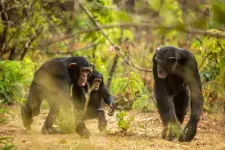(Press-News.org) Ancient frog relatives survived the aftermath of the largest mass extinction of species by feeding on freshwater prey that evaded terrestrial predators, University of Bristol academics have found.
In the study, published today in the journal Royal Society Open Science, their findings suggest the amphibians’ success lay in their generalist feeding ecology, enabling them to feed on a wide variety of prey despite the array of environmental changes happening all around them through the Triassic. Broader examination of Triassic ecosystems also indicates that the freshwater habitats they preferred provided them with a relatively stable variety of food resources, allowing them to thrive while strictly terrestrial predators made do with meagre, unstable resource availability on land.
The end-Permian mass extinction event, 252 million years ago, was the largest ever, marked by the loss of as many as 90% of species. A key line of research has been to focus on the survivors and their fate in the Triassic, the timespan that followed the Permian.
“One of the great mysteries has been the survival and flourishing of a major group of amphibians called the temnospondyls,” explained lead author Aamir Mehmood from Bristol’s School of Biological Sciences. “These were predatory animals that fed on fishes and other prey, but were primarily linked to the water, just like modern amphibians such as frogs and salamanders. We know that climates then were hot, and especially so after the extinction event. How could these water-loving animals have been so successful?”
The Early Triassic was a time of repeated volcanic activity leading to long phases of global warming, aridification, reductions in atmospheric oxygen, acid rain and widespread wildfires, creating conditions so hostile that the tropics became devoid of animal life. This ‘tropical dead zone’ drastically impacted the distributions of both marine and terrestrial organisms.
Co-author Dr Suresh Singh said: “We collected data on 100 temnospondyls that lived throughout the Triassic and wanted to look at how their ecologies changed.
“We measured their body sizes and features of the skulls and teeth that tell us about function.”
“Much to our surprise, we found that they did not change much through the crisis,” said co-author Dr Armin Elsler. “The temnospondyls showed the same range of body sizes as in the Permian, some of them small and feeding on insects, and others larger. These larger forms included long-snouted animals that trapped fishes and broad-snouted generalist feeders.
“What was unusual though was how their diversity of body sizes and functional variety expanded about 5 million years after the crisis and then dropped back.”
Due to the intense global warming of the first five million years of the Triassic, there is evidence that life on land and in the sea moved away from the tropics to avoid the heat.
Professor Mike Benton explained: “Our work shows that the temnospondyls, unexpectedly, were able to cross the tropical dead zone.
“Fossils are known from South Africa and Australia in the south, as well as North America, Europe and Russia in the north. The temnospondyls must have been able to criss-cross the tropical zone during cooler episodes.”
Aamir concluded: “Their burst of success in the Early Triassic was not followed up.
“They coped with the hot conditions probably by having a low requirement for food, by being able to eat most prey animals, and by hiding in sparse water bodies. But when the ancestors of dinosaurs and of mammals began to diversify in the Middle Triassic, the temnospondyls began their long decline.”
Paper:
‘The ecology and geography of temnospondyl recovery after the Permian – Triassic mass extinction’ by Aamir Mehmood, Dr Suresh Singh, Dr Armin Elsler and Professor Michael Benton in Royal Society Open Science.
END
Amphibians bounce-back from Earth’s greatest mass extinction
2025-03-05
ELSE PRESS RELEASES FROM THIS DATE:
Better semen quality is linked to men living longer
2025-03-05
Men’s semen quality is associated with how long they live according to a study of nearly 80,000 men, which is published today (Wednesday) in Human Reproduction [1], one of the world’s leading reproductive medicine journals.
The study followed the men for up to 50 years and found that those with a total number of motile sperm (sperm that can move or ‘swim’) of more than 120 million could expect to live two to three years longer than men with a total motile sperm count of between 0 and 5 million.
This is the largest study to examine the link between semen quality and mortality. An accompanying editorial ...
Enhancing mosquito repellent effectiveness
2025-03-05
RIVERSIDE, Calif. -- In a recent study, researcher Anandasankar Ray at the University of California, Riverside, and his team employed machine learning techniques combined with cheminformatics to predict novel mosquito repellents that could greatly improve global mosquito control efforts. Using the same approach to combat the global threat of mosquito-borne diseases such as malaria and dengue, Ray, the recipient of a $2.5 million, five-year grant from the National Institutes of Health, or NIH, will now work on identifying novel spatial mosquito repellents ...
Prenatal maternal stressors linked to higher blood pressure during first year after birth, study shows
2025-03-05
Psychosocial stress during pregnancy could lead to higher blood pressure during the first year postpartum according to research from Keck School of Medicine of USC.
The study, published in Hypertension and supported by the National Institutes of Health, investigated whether mothers who reported higher perceived stress and depressive symptoms during pregnancy, developed higher blood pressure in the four-year period after birth. The findings showed higher stress and depressive symptoms during pregnancy were associated with greater blood pressure during the first year postpartum, but associations diminished thereafter.
“Pregnancy ...
Resistance exercise may be best type for tackling insomnia in older age
2025-03-05
Resistance or muscle strengthening exercise, using weights or the body itself, may be the best type of exercise for tackling insomnia in older age, suggests a pooled data analysis of the available research, published in the open access journal Family Medicine and Community Health.
Aerobic exercise or a mix of strength, aerobic, balance, and flexibility exercises also seem to be effective, the analysis indicates.
Sleep quality tends to decline with age. And up to 1 in five older adults has insomnia, ...
Global 130%+ rise in postmenopausal osteoarthritis and associated disability over past 3 decades
2025-03-05
The global number of cases of osteoarthritis, as well the disability associated with the condition, have risen by more than 130% over the past 3 decades among women who have gone through the menopause, indicates a data analysis spanning 1990 to 2021, and published in the open access journal BMJ Global Health.
During this period, East Asia and high income Asia Pacific countries experienced the fastest growth in the condition while excess weight accounted for 20% of the total years lived with the resulting disability, the analysis indicates.
Osteoarthritis is primarily characterised by the deterioration and damage ...
OU Health Sciences rises to 102 in national ranking
2025-03-05
OKLAHOMA CITY – The University of Oklahoma Health Sciences has achieved its highest ranking ever in National Institutes of Health funding awarded for research. NIH funding increased to $75.2 million in the previous federal fiscal year, improving the campus’s ranking to 102 out of 2,838 institutions and other entities that receive NIH funding.
OU Health Sciences’ previous ranking was 122. Of the total amount of funding, $65.3 million was awarded to the OU College of Medicine, whose faculty members cross 23 academic departments ...
Bonobos and chimps offer clues to how our early ancestors had sex for social purposes
2025-03-05
We don’t just have sex to reproduce - new research suggests that using sex to manage social tension could be a trait that existed in the common ancestor of humans and apes six million years ago.
Humans share this behavioural strategy with our closest living ape relatives – bonobos and chimpanzees.
Now researchers, led by Durham University, UK, have undertaken what is thought to be one of the first direct comparisons of sexual behaviour amongst bonobos and chimpanzees during periods of social stress.
Their findings, published ...
Lebanon multidimensional crisis diminishing trust in public education and worsening inequality, study shows
2025-03-04
Diminished trust in public education in crisis-hit Lebanon is worsening inequality in the country and forcing parents to make difficult decisions, a new study warns.
The country’s dual education system, reinforced by religious and political policies, continues to favour the upper classes, exacerbating educational disparities between social groups.
Lebanon’s sectarian government and weak state has led parents to perceive the academic and non-academic outcomes of most private schools as better than those of public schools.
Many said this perception has intensified recently due to declining government funding, ...
Cold atoms on a chip
2025-03-04
(Santa Barbara, Calif.) — UC Santa Barbara researchers are working to move cold atom quantum experiments and applications from the laboratory tabletop to chip-based systems, opening new possibilities for sensing, precision timekeeping, quantum computing and fundamental science measurements.
“We’re at the tipping point,” said electrical and computer engineering professor Daniel Blumenthal.
In an invited article that was also selected for the cover of Optica Quantum, Blumenthal, along with graduate student researcher Andrei Isichenko and postdoctoral researcher Nitesh Chauhan, lays out the latest developments ...
Rice University study reveals how rising temperatures could lead to population crashes
2025-03-04
Researchers at Rice University have uncovered a critical link between rising temperatures and declines in a species’ population, shedding new light on how global warming threatens natural ecosystems. The study, published in Ecology and led by Volker Rudolf, revealed that rising temperatures exacerbate competition within populations, ultimately leading to population crashes at higher temperatures. It offers one of the first clear experimental confirmations that rising temperatures alter the forces that control population dynamics in nature.
“Our research provides an essential ...




